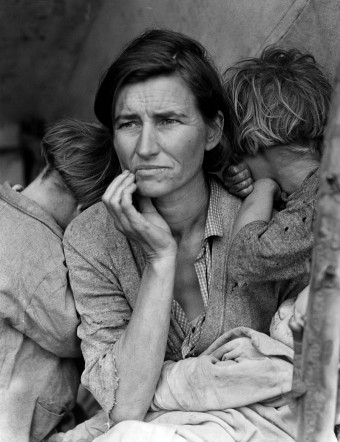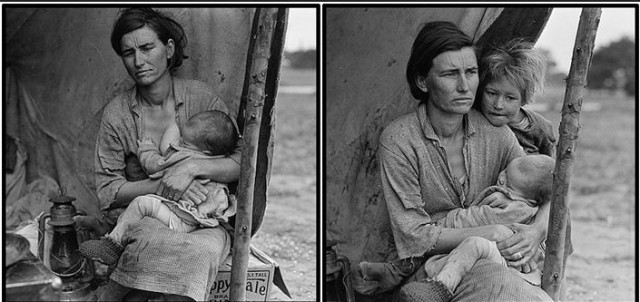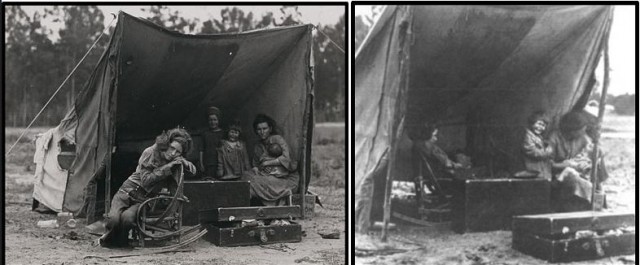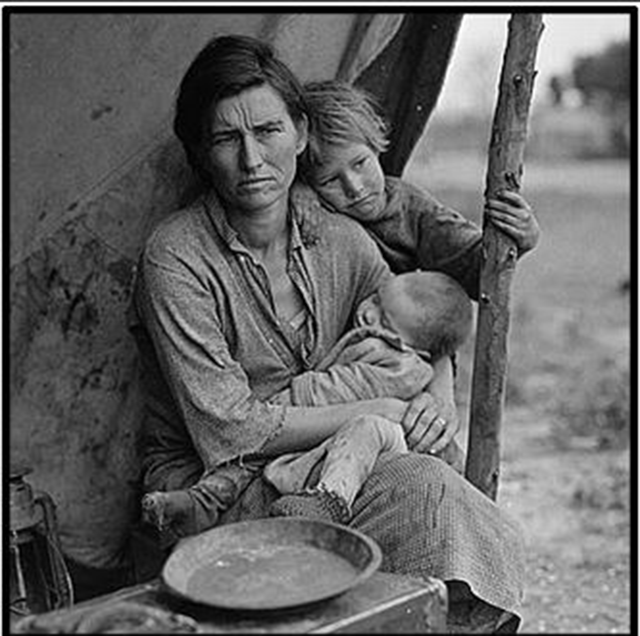Who was the Woman in the Famous Great Depression Photograph?
 The Great Depression, the worst economic downturn in the history of the United States and the Western world, began on October 24, 1929, a day that has gone down in the history books as Black Thursday. The economy went into a tailspin with businesses laying off workers and wages for those still employed plummeting. Between 13 million and 15 million Americans were unemployed (about 11%-13% of the population) and couldn’t find work at the peak of the Great Depression in 1933.
The Great Depression, the worst economic downturn in the history of the United States and the Western world, began on October 24, 1929, a day that has gone down in the history books as Black Thursday. The economy went into a tailspin with businesses laying off workers and wages for those still employed plummeting. Between 13 million and 15 million Americans were unemployed (about 11%-13% of the population) and couldn’t find work at the peak of the Great Depression in 1933.
Farmers in the Plains states were hit the hardest. The drought of the 1920s put them in a tight spot where a number of farmers couldn’t afford to harvest their crops and let them rot in the field. The drought ultimately led to the Dust Bowl, massive dust storms that further hit American farms hard. While seventy-five percent of farmers remained on their farms, a massive portion of the farming population abandoned them due to the Dust Bowl or because banks foreclosed on their land. Approximately 2.5 million people moved out of the Plains states by the year 1940 with about 200,000 moving to California.
Florence Owens Thompson, a woman whose picture became the symbol of poverty during the Great Depression, was already on the West Coast and could’ve reported that the job market wasn’t any better there. Born in Oklahoma in 1903, Thompson’s family no longer lived on their Cherokee tribal lands after being evicted by the U.S. government. She met her first husband, Cleo Owens, in Mississippi after her family moved to the state. They married in 1921, and she moved with him and members of his family to the area around Sacramento, California to look for work. When Cleo died in 1931, the couple had five children and Thompson was pregnant with their sixth.
Over the next five years, Thompson had a seventh child and began a relationship with a man named Jim Hill. The two never married, though they settled into life in the San Joaquin Valley where they worked as itinerant farm laborers. It was there that she met Dorothea Lange, the photographer who took the iconic Migrant Mother picture.
On the day that Lange took the Migrant Mother photograph (and others of Thompson, see the Bonus Facts below), Thompson sat on the side of the road with five of her children. The family’s car had broken down while they were on their way to pick lettuce, and Jim Hill had taken the two oldest boys with him to have the radiator fixed in town. It just happened that they left Thompson and the other children next to a migrant camp that housed at least 2,500 workers.
Lange initially drove past the camp on her way home after photographing workers around Los Angeles, but she turned around because she believed that she might find more subjects to photograph. She convinced a reluctant Thompson to sit for six pictures that day, including the Migrant Mother. She left after only asking Thompson’s age and how many children she had in her family.
By the time that Migrant Mother was published in the newspaper and the government sent food to that worker camp as a result, Florence Owens Thompson and her family had already moved on. They learned about the photograph when one of her sons brought home a copy of the newspaper with the picture from his paper route. According to one of Thompson’s daughters who gave an interview after her mother’s death, the family wasn’t happy about the Migrant Mother photograph: “We were ashamed of it. We didn’t want no one to know who we were.”
Thompson didn’t publicly identify herself as the Migrant Mother for almost forty years. She spent that time quietly working, growing her family and marrying a man named George Thompson. NBC’s Bob Dotson tracked down Thompson to a trailer park near Modesto, California, in 1979. For the first time she spoke, on television, about the photograph and Dorothea Lange.
When the picture was taken, she claimed that Lange assured her the picture would never be published. She also said that Lange promised to send her a copy and she never did. She also stated that Lange made up many of the details of Thompson’s predicament, such as that the family had sold the tires on their car to buy food. As Thompson said, “There’s no way we sold our tires, because we didn’t have any to sell. The only ones we had were on the Hudson and we drove off in them. I don’t believe Dorothea Lange was lying, I just think she had one story mixed up with another. Or she was borrowing to fill in what she didn’t have.”
Florence Owens Thompson suffered a stroke in August of 1983. Her family couldn’t afford the medical treatment, so they took advantage of their mother’s status as the Migrant Mother. They raised over $25,000 (about $58,000 today) for her medical care through donations from the American public. That experience changed the family’s opinion of the photograph as they realized how many people their mother’s picture touched. Thompson died several weeks later, shortly after her 80th birthday.
If you liked this article, you might also enjoy our new popular podcast, The BrainFood Show (iTunes, Spotify, Google Play Music, Feed), as well as:
- Why the Man in the Famous “Saigon Execution” Photo was Killed
- The Origin of “Say Cheese” and When People Started Smiling in Photographs
- Scrabble and the Great Depression
- How an Unemployed Accountant Who Didn’t Play Any Instrument Founded One of the Biggest Music Companies in the World During the Great Depression
- The First Stock Market Crash: The South Sea Company
Bonus Facts:
- Despite taking the “Migrant Mother” photograph, Dorothea Lange didn’t make all that much money from it, mostly just gaining notoriety as a photographer. When she took it, she was being funded by the federal government, more specifically for the Farm Security Administration as a documentary photographer, traveling the country to document the everyday struggles of American workers. This ultimately meant the U.S. government owns the rights to the picture, not Lange. Thus, it is in the public domain, free for anyone to use.
- Popcorn saw its biggest surges in popularity during the Great Depression and WWII, the former of which because popcorn was an extremely cheap snack, being one of the few snack items many families could afford. Popcorn saw another huge surge in popularity during WWII, thanks to sugar rations, which made candy much more expensive and hard to come by. During WWII alone, Americans began eating three times more popcorn than they had before the war. After the war, as more and more people started staying home and watching TV, rather than going to the movies, and sugary snacks were once again readily available and cheap, popcorn sales fell somewhat. However, within a decade they surpassed the WWII numbers thanks to a partnership between the Popcorn Institute, Coca-Cola, and Morton Salt, who heavily campaigned to convince people that popcorn and Coke made a great snack while watching TV. Yet another surge happened in the 1980s, thanks to the now ubiquitous microwave, as well as the commercial availability of shelf stable (doesn’t need refrigerated), flavored microwave popcorn, the first of which was ACT II.
- The popcorn machine was invented in 1885 by a confectionery shop owner, Charles Cretors. He purchased a peanut roasting machine for his shop, which didn’t work very well, so he redesigned it. His redesign allowed for not only roasting peanuts, but also evenly popping popcorn in seasoning. This was a far superior method of making popcorn over the classic wire-basket over an open flame with seasoning added after it was popped method. He then began selling this machine commercially and today the vast majority of professional poppers, including those at most movie theaters, are still made by the Cretors family via C. Cretors & Company.
- In order to add realism to his Great Depression-era novel The Grapes of Wrath, John Steinbeck lived with an Oklahoma family and traveled with them to California in the name of research.
- The police chief in Los Angeles decided to use his police force in order to stop (illegally) the wave of migrant workers coming into California during the Great Depression. He sent over 100 policemen to the state border with the order to turn away migrants deemed to be undesirable. You can read more about this here: The Bum Brigade.
- Lange took five more photos of Thompson and her family that aren’t so famous. You can see these below:
| Share the Knowledge! |
|








I learned in a history class that the famous photo Lange took of the ‘Migrant Mother’ was purposely cropped in order not to show all the children, but just the mother and a few children. Lange apparently thought that showing all the children would diminish the sympathy evoked in the viewer, by provoking a counter feeling that the mother shouldn’t have had so many children, given her dire situation.